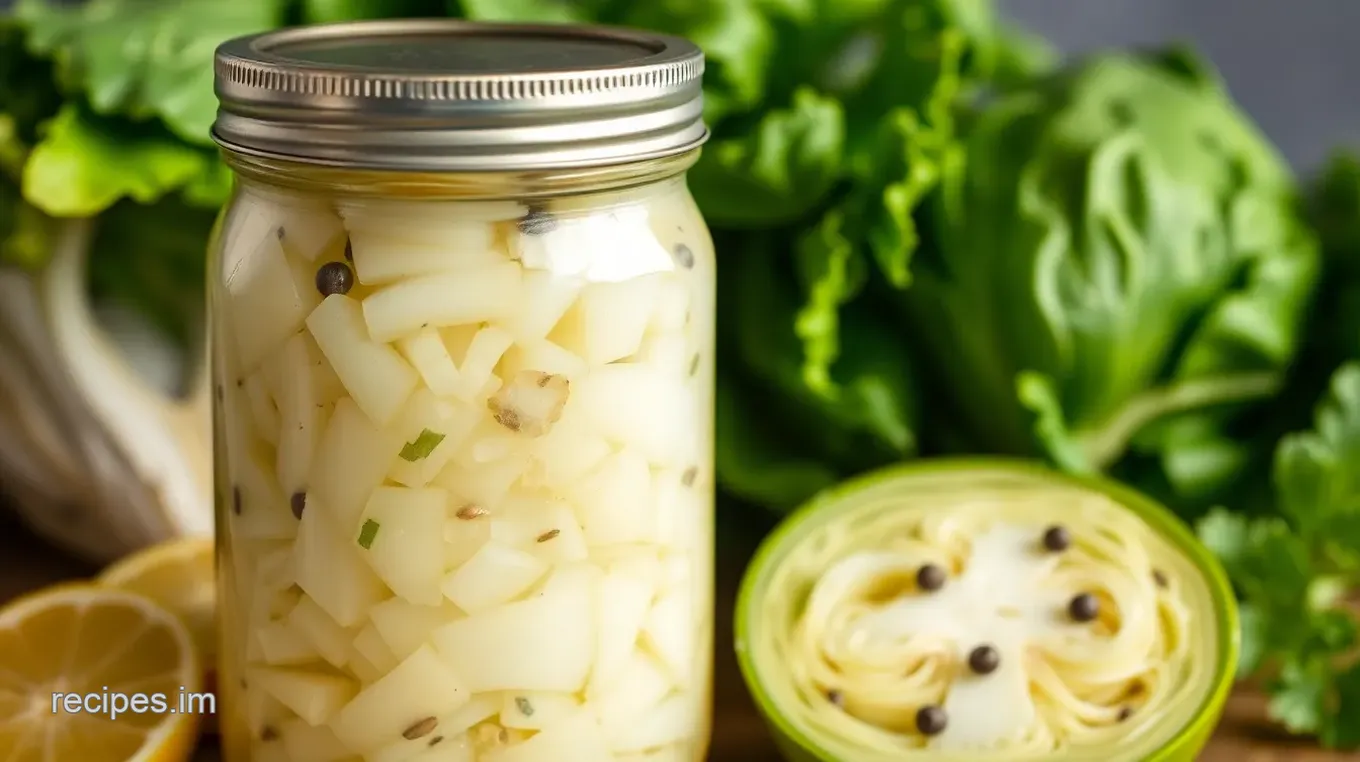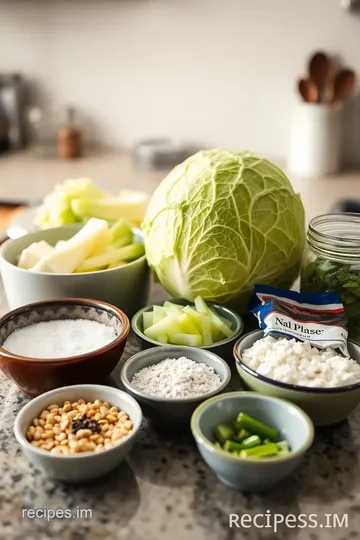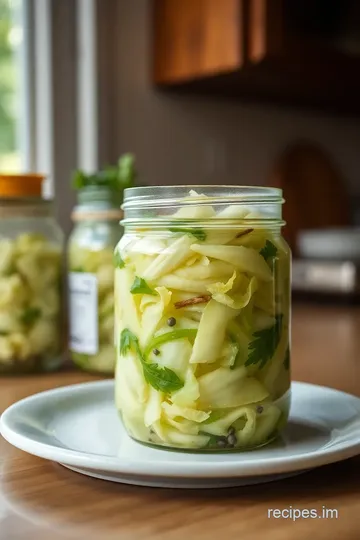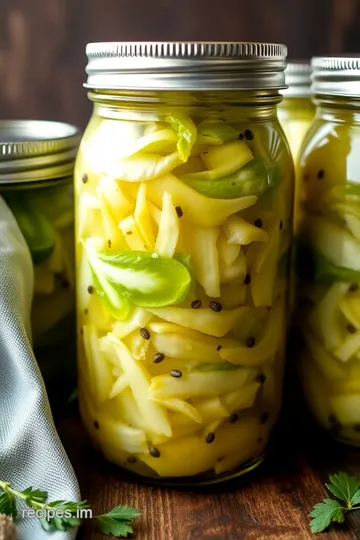Fermenting Cabbage: Zesty Homemade Sauerkraut in a Jar
Ever wondered about fermenting cabbage? Try my easy, delicious jarred sauerkraut recipe! It's a tangy delight packed with probiotics. Perfect for hearty meals.

- Finding My Fermentation Flow: The Story of Sauerkraut
- A Snapshot of Sauerkraut History
- Sauerkraut’s Superpowers
- Why Homemade is the Way to Go
- Let’s Get to Those Ingredients
- Your Go-To Guide for Essential Ingredients
- Mastering Professional Cooking Method: The Art of Fermentation
- Pro Tips & Secrets
- Perfect Presentation
- Storage & Make-Ahead
- Creative Variations
- Complete Nutrition Guide
- Frequently Asked Questions
- Recipe Card
Finding My Fermentation Flow: The Story of Sauerkraut
Oh my gosh, i remember the first time i tried my hand at fermenting cabbage . it was a chilly saturday afternoon in the dead of winter, and i was looking for something to brighten up my dreary day.
When i spotted a hefty green cabbage at the store, i had this spontaneous urge to go full-on fermentation lab .
I mean, what could go wrong, right? i had no clue that i was about to dive into the world of delicious jarred sauerkraut .
Sauerkraut isn’t just sliced cabbage; it’s a tangy treasure trove of probiotic-rich foods . and let’s be real: if you’ve ever had a reuben, you know sauerkraut adds that zesty kick.
So, let’s explore this age-old recipe that’s been jazzing up our meals for generations!
A Snapshot of Sauerkraut History
So, where did sauerkraut come from, anyway? it’s not just a german staple—its roots stretch all the way back to ancient china! originally made with fermented cabbage to preserve it, this method spread to europe where it was embraced, especially in germany.
These days, its crisp, tangy bite is super popular, showing up in everything from street food to fancy gastro pubs.
What i love about it is how simple it is to make: just cabbage, salt, and a bit of time .
If you’ve got 20 minutes of active prep time, a month of patience (yes, really), and a couple bucks, you’re golden! who knew becoming a home fermenter was this easy?
Sauerkraut’s Superpowers
Now let’s talk about the benefits of sauerkraut . besides being downright delicious, it's a gut-health game changer thanks to lactobacillus bacteria .
These little guys work wonders for your digestion. in fact, eating raw sauerkraut can give you those extra dietary fibers to help keep your gut running smoothly.
Plus, it’s low-calorie! who doesn’t appreciate a tasty condiment that won’t blow their diet?
Honestly, this stuff is perfect for gatherings too. whether it’s a summer bbq with brats or a cozy winter soup night with friends, sauerkraut fits right in.
It’s like that one friend who gets along with everyone!
Why Homemade is the Way to Go
Now, let’s be real; while you can grab a jar from the store, homemade sauerkraut is an entirely different experience.
There's a satisfaction that comes from doing it yourself. you can customize it to your liking, adding in spices or veggies to suit your palate.
Feeling adventurous? try making spicy sauerkraut with some chili flakes!
And because you’re the one fermenting, you’ll know exactly how it was made and can feel good about your choices.
Plus, cabbage fermentation tips are everywhere these days! you’d be surprised how many people are eager to share their sauerkraut variations.
Speaking of jars, make sure you have the right equipment—getting a good fermentation jar with a lid is crucial to keep everything in check.
Trust me; you don’t want to mess this up!
Let’s Get to Those Ingredients
So, now that you’re all excited about making your own sauerkraut, let’s dive into what you’re gonna need. you really only need a few things: fresh green cabbage, sea salt, and an optional spice or two.
The best cabbage for sauerkraut ? a medium-sized green cabbage is perfect.
Grab your mixing bowl and let’s get started creating some zesty goodness! I promise you the journey of fermenting cabbage will be one for the books.
Get ready to carry on this flavorful tradition, and soon enough, you’ll be enjoying your own homemade sauerkraut with those epic serving ideas I’ve got waiting up next!

Your Go-To Guide for Essential Ingredients
Cooking is all about the ingredients, right? having the right ones on hand makes whipping up dishes like fermenting cabbage: delicious jarred sauerkraut a total breeze.
Here’s your handy guide to ensure your kitchen game is always on point.
Premium Core Components
Let’s kick things off with the basics. We’re talking about those essential ingredients you can’t do without. Here’s a quick breakdown:
-
Measurements: Always have your 1 cup/240 ml handy for liquids and 1 tablespoon/15 ml for solids. Trust me; it’ll save you from disaster!
-
Quality Indicators: Look for ingredients that are fresh and vibrant. Spinach should be crisp, garlic should have a strong scent, and your spices shouldn’t look like they’ve been around since Aunt Edna's youth—check their expiration date!
-
Storage guidelines: most herbs stay fresh in the fridge, while spices can live in a cool, dark cupboard for about 1-2 years .
Pay attention to those storage tips for longer shelf life.
-
Freshness Tips: Always pick what’s in season. Seasonal veggies are not just tastier but usually cheaper too!
Signature Seasoning Blend
This is where the magic happens! You gotta have your signature seasoning blend in place if you want to embrace those flavors.
-
Essential Spice Combos: Think garlic powder, paprika, and pepper. Mix them up for the ultimate kick.
-
Herb Selections: Herbs like thyme and basil can elevate pretty much anything. Trust me on this!
-
Flavor Enhancers: Use onions , ginger , and fresh herbs to take your food from bland to wow.
-
Regional Variations: Go wild! Add cumin for Mexican flair or curry powder if you're feeling adventurous!
Smart Substitutions
We all know life gets busy. So, let's talk smart substitutions that keep you cookin’:
-
Common Alternatives: No fresh basil? Dried works, but you’ll need less—about 1 teaspoon instead of a tablespoon.
-
Dietary Modifications: Got gluten sensitivities? Use gluten-free soy sauce instead.
-
Emergency Replacements: Out of salt? Grab some soy sauce! Just adjust other salty ingredients you might be using.
-
Seasonal Options: If fresh veggies are out of season, frozen can work too—just thaw and chop!
Kitchen Equipment Essentials
Did you know having the right tools makes everything easier? Seriously, don’t skimp on these kitchen equipment essentials :
-
Must-Have Tools: A good knife, cutting board, pot, and mixing bowl will get you far.
-
Alternative Options: No whisk? A fork can do the job just fine.
-
Preparation Tips: Try to chop in batches. It saves you time later on.
-
Storage Solutions: Invest in a few good glass containers. They keep your ingredients fresh and are totally microwave-safe!
So, now that you have a game plan for the essentials, let’s dive into the fun part—making that delicious jarred sauerkraut .
To perfectly harness the fermentation process, you’ll want to follow a simple homemade sauerkraut recipe that's not just easy but super beneficial for your gut health.
Not to mention, who doesn’t love a tangy condiment that amps up meals?
Remember, homemade sauerkraut is not just a sidekick to your sausages; it also packs a punch with probiotic-rich foods! so, let’s get fermenting and bring those nutritional benefits of cabbage right to your table.
Ready to start? let’s roll up our sleeves and make some magic!

Mastering Professional Cooking Method: The Art of Fermentation
Cooking isn’t just about getting from a to b; it’s about enjoying the journey! and when it comes to fermenting cabbage: delicious jarred sauerkraut , there’s an undeniable joy in the process.
Trust me, once you dive into this world, you’ll be ready to send off your best friend a jar of your homemade sauerkraut.
The journey starts here, and with a few essential preparation steps, you’ll be a pro in no time.
Essential Preparation Steps
First off, let’s talk mise en place —a french term that sounds fancy but just means having everything ready to go.
Chop your medium green cabbage , grab your sea salt , and set up your workspace. having everything lined up within arm’s reach makes your life so much easier.
This way, you won’t be scrambling to find that pesky jar when you've got cabbage juice dripping down your arms—trust me, it’s a scene!
Time management is also super important. you’ll want to carve out 20 minutes for prep , but don’t forget about the 1-4 weeks of fermentation time ! yeah, that’s a big range, but we’ll get to that in a sec.
Try setting a reminder every few days to check on your jar; otherwise, a forgotten jar can lead you into uncharted, sour territory.
Now let’s chat organization. i always keep my mixing bowl , fermenting weight , and jar close by. it feels like a mini cooking station! safety is key, too.
Wash everything well. there’s nothing worse than inviting unwanted bacteria into your delicious creation. we want lactobacillus bacteria , not the kind that’ll ruin your sauerkraut vibes!
Step-by-Step Process
Alright, fluff your apron and let’s jump into the step-by-step instructions for this sauerkraut goodness.
-
Prepare the Cabbage: Start by removing those outer leaves. Cut it into quarters, and then slice it into thin shreds, about ¼-inch wide .
-
Mix with salt: toss that shredded cabbage into your mixing bowl. sprinkle your 1 tablespoon of sea salt over it.
Now, here’s the fun part: get your hands in there and massage it for 5- 10 minutes . you’re basically giving it a spa day until it releases all that moisture.
-
Add Flavorings: If you wanna spice things up, toss in 1 teaspoon of caraway seeds . They add a lovely, earthy flavor!
-
Pack into Jar: Move your cabbage mix into the jar. Press it down firmly so there are no air pockets. Bubbles aren’t a friend here!
-
Add Weight: Create pressure with a clean weight—maybe a rock or marbles—to keep your cabbage submerged under its brine.
-
Seal and store: cover your jar with a clean cloth, secured with a rubber band. this lets your sauerkraut breathe! store in a cool, dark place—ideally between 60- 70° f or 15- 21° c .
-
Ferment: Here’s the magic! Check on it every few days. Taste it after one week, but be patient; it could take up to a month depending on how tangy you want it!
-
Transfer to Storage: Once it hits that perfect flavor, cap it off and toss it in the fridge. This slows down the fermentation process, so you can savor your sauerkraut for weeks!
Expert Techniques
As you level up to the professional cooking method, keeping an eye on temperature control points becomes essential. if it’s too warm, you may end up with over-fermented cabbage that tastes like something you wouldn’t want to find in the back of your fridge.
And here’s a tip: keep an eye out for quality checkpoints ! like—bright, crisp texture and a slightly tangy aroma.
If it smells off, it’s probably time to toss it. better safe than sorry!
Not sure if you nailed it? Troubleshoot any issues by adjusting salt levels or checking fermentation time. Remember, cooking is all about experimenting!
Success Strategies
Lastly, let’s shoot down those common mistakes to avoid. over-salting can turn your homemade sauerkraut recipe into a salt lick, so be cautious! and don’t leave the weight out; that cabbage needs to stay submerged to keep it safe from mold.
If you’re worried about running out, this process is great for make-ahead options . just set up multiple jars and stagger your fermentation times.
You’ll be the hero of gut health with your stash of probiotic-rich foods !
The journey of sauerkraut making not only adds zing to your meals but offers delish benefits. so whether you’re taking it the traditional route or trying a spicy sauerkraut variant, you'll soon appreciate the beauty of cabbage fermentation .
Ready to tackle the next section? Let’s dive deeper into more tips and tricks to elevate your sauerkraut game and explore how to make the most of this delicious, tangy treat!

Pro Tips & Secrets
When it comes to fermenting cabbage: delicious jarred sauerkraut , having a few pro tips up your sleeve can totally change the game.
First, let’s talk time-saving techniques . if you're super busy (aren’t we all?), try prepping a big batch on a lazy sunday.
You can sip coffee while the cabbage fermentation does its thing. it’s a win-win—your kitchen smells amazing, and you’ve got good gut health coming your way!
For flavor enhancement , don’t skimp on that salt! the sea salt not only helps draw moisture from the cabbage but also creates the perfect environment for the lactobacillus bacteria to thrive.
How exciting is that? and, hey, if you want a kick, toss in some spicy sauerkraut ideas like chili flakes or finely chopped jalapeños—trust me, your taste buds will dance!
Now, for presentation advice , think of sauerkraut as more than a side. you can serve it proudly! place it in a colorful bowl, and maybe sprinkle some fresh herbs on top.
Seriously, it elevates the whole vibe. people are already impressed with your culinary skills when you whip out homemade condiments!
Perfect Presentation
Let’s move onto plating. make the dish pop! layer your sauerkraut over a robust slice of rye bread for a killer open-faced sandwich.
The color combinations of the vibrant kraut and dark bread are not just visually appealing, they also scream german cuisine .
For garnish ideas, fresh chives or dill can really elevate your dish. who knew sauerkraut could look so good, right? remember, visual appeal matters; it’s all about that instagram-worthy snapshot.
If you feel extra fancy, use your best serving dishes—show off your creation!
Storage & Make-Ahead
Wondering about storage? here’s the scoop! once your sauerkraut is fermented to perfection, transfer it to the fridge in an airtight container.
This will significantly slow down the fermentation. to preserve that crunch and flavor, consume it within a month. the freshness duration can vary, but the taste is best within that time frame.
Reheating instructions ? you don’t typically heat sauerkraut, but if you want to warm it up for a dish, do so gently on the stove.
Too much heat can kill off those fantastic probiotics. no one wants to lose those sauerkraut health benefits !
Creative Variations
One of the best parts about this homemade sauerkraut recipe is that it’s like a blank canvas. Want to play around with flavor adaptations ? You could go sweet and add apple slices for a different twist—perfect for the fall! Or have fun with seasonal veggies; how about adding some fresh dill in the summer?
For dietary modifications , this recipe is naturally vegan and gluten-free. so anyone can enjoy it! you could also vary your cabbage.
Ever tried red cabbage ? it’s not just pretty—it also brings its own unique flavor to the party.
Complete Nutrition Guide
Let’s get serious for a sec—this sauerkraut isn’t just a tasty addition to your meals. it packs in some serious nutritional benefits .
We’re talking about good doses of dietary fibers in sauerkraut . plus, if you're in the gut health game, this is your mvp! the probiotics from fermented foods like this help balance your gut microbiome.
Overall, it amounts to about 30 calories per serving (yep, you heard that right!).
And, with the nutritional benefits of cabbage , your gut and body will thank you for every bite of your homemade sauerkraut.
So there you have it! with a bit of patience and practice, fermenting cabbage: delicious jarred sauerkraut can be done right in your kitchen.
It’s fun, it’s creative, and honestly, nothing quite beats the satisfaction of making something from scratch. so grab your cabbage and let the fermentation magic happen! you’ve got this—let’s get sauerkrauting!
Frequently Asked Questions
What is the best way to store my fermented sauerkraut?
Once your sauerkraut has reached the desired taste after fermentation, transfer it to the refrigerator. This will slow down the fermentation process significantly, preserving its flavor and texture. Make sure to use a sealed jar to keep it fresh; it can last for several months if kept cold!
How long should I ferment cabbage when making sauerkraut?
For "Fermenting Cabbage: Delicious Jarred Sauerkraut," the fermentation time typically ranges from 1 to 4 weeks. The exact time depends on the temperature of your storage area and your taste preferences. Check the flavor weekly and stop fermentation once it reaches your desired sourness.
Can I use other types of cabbage for this sauerkraut recipe?
Absolutely! While green cabbage is traditional for sauerkraut, you can also use red cabbage or a mix of both for added color and flavor. Just keep in mind that different cabbages might alter the taste and fermentation time slightly.
What are some ways to customize my homemade sauerkraut?
You can personalize your sauerkraut by adding spices like dill or garlic, or other vegetables such as shredded carrots and beets. Experiment with different combinations to find your perfect flavor profile while fermenting cabbage!
Is homemade sauerkraut healthier than store-bought?
Yes! Homemade sauerkraut typically contains more probiotics because it is unpasteurized and has no preservatives. Additionally, you can control the amount of salt and any added ingredients, making it a healthier option tailored to your dietary needs.
What should I do if my sauerkraut doesn't seem to be fermenting?
If your sauerkraut isn't fermenting, ensure that it's kept at the right temperature (60-70°F or 15-21°C) and that the cabbage is fully submerged in its brine. If it still doesn't ferment after a week, you may need to check the salt balance or environmental conditions. Sometimes, beet juice or extra salt can help kickstart fermentation!
Fermenting Cabbage: Zesty Homemade Sauerkraut in a Jar Card

⚖️ Ingredients:
- 1 medium green cabbage (about 2 pounds or 900 grams)
- 1 tablespoon sea salt (15 grams)
- Optional: 1 teaspoon caraway seeds (5 grams)
🥄 Instructions:
- Step 1: Remove outer leaves, then cut the cabbage into quarters and remove the core. Slice the cabbage into thin shreds (about ¼-inch wide).
- Step 2: In a large bowl, combine sliced cabbage with sea salt. Massage and squeeze the cabbage for about 5-10 minutes until it starts to release moisture.
- Step 3: Mix in caraway seeds if using.
- Step 4: Transfer the cabbage mixture into the glass jar, pressing down firmly with each handful to eliminate air pockets.
- Step 5: Place a clean weight on top of the cabbage to keep it submerged under its brine.
- Step 6: Cover the jar with the cloth secured by a rubber band to allow airflow while keeping dust out. Store in a cool, dark place (60-70°F or 15-21°C).
- Step 7: Check the sauerkraut every few days, pressing it down to keep it submerged. Taste after one week and continue to ferment until it reaches your desired flavor (up to a month).
- Step 8: Once fermented, seal the sauerkraut with a lid and refrigerate to slow fermentation.
Previous Recipe: Ultimate Hearty Cooked Sauerkraut with Sausages: 5 Delicious Tips!
Next Recipe: Ultimate Fried Chicken Ogre Toes Delight Recipe: 5 Amazing Crunchy Tips!
